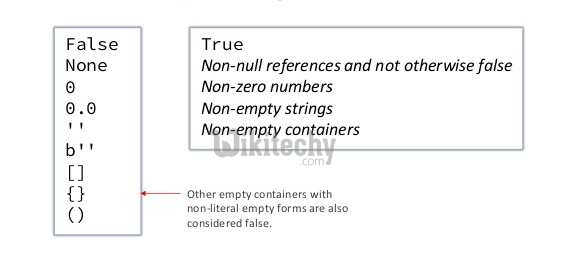python tutorial - String Literal | Python Literals - learn python - python programming
- Literals can be defined as a data that is given in a variable or constant.
- Python support the following literals:
I. String literals:
- A "string literal" is a sequence of characters from the source character set enclosed in double quotation marks (" ").
- String literals are used to represent a sequence of characters which, taken together, form a null-terminated string.
- String literals can be formed by enclosing a text in the quotes.
- We can use both single as well as double quotes for a String.
- Objects are also called data structures.
- Python comes with some built-in objects.
- Some are used so often that Python has a quick way to make these objects, called literals.
- The literals include the string, Unicode string, integer, float, long, list, tuple and dictionary types.
Eg:
"Aman", '12345'
click below button to copy the code. By Python tutorial team
Types of Strings:
- There are two types of Strings supported in Python:
- Single line String
- Multi line String
a. Single line String - Strings that are terminated within a single line are known as Single Line Strings.
Eg:
>>> text1='hello' click below button to copy the code. By Python tutorial team
- There are two ways to create Multiline Strings:
b. Multi line String - A piece of text that is spread along multiple lines is known as Multiple Line String.
1). Adding black slash at the end of each line.
Eg:
>>> text1='hello\
user'
>>> text1
'hellouser'
>>>
click below button to copy the code. By Python tutorial team
2). Using triple quotation marks: -
Eg:
>>> str2='''''welcome
to
Wikitechy'''
>>> print str2
welcome
to
Wikitechy
>>> click below button to copy the code. By Python tutorial team
II. Numeric literals:
- Numeric Literals are immutable. Numeric literals can belong to following four different numerical types.
| Int(signed integers) | Long(long integers) | float(floating point) | Complex(complex) |
|---|---|---|---|
| Numbers (can be both positive and negative) with no fractional part. eg: 100 |
Integers of unlimited size followed by lowercase or uppercase L eg: 87032845L |
Real numbers with both integer and fractional part eg: -26.2 |
In the form of a+bj where a form the real part and b forms the imaginary part of complex number. eg: 3.14j |
III. Boolean literals:

- A Boolean literal can have any of the two values: True or False.
IV. Special literals.
- Python contains one special literal i.e., None.
- None is used to specify to that field that is not created.
- It is also used for end of lists in Python.
Eg:
>>> val1=10
>>> val2=None
>>> val1
10
>>> val2
>>> print val2
None
>>>click below button to copy the code. By Python tutorial team
V. Literal Collections.
- Collections such as tuples, lists and Dictionary are used in Python.
List:
- List contain items of different data types. Lists are mutable i.e., modifiable.
- The values stored in List are separated by commas (,) and enclosed within a square bracket ([]). We can store different type of data in a List.
- Value stored in a List can be retrieved using the slice operator ([] and [:]).
- The plus sign (+) is the list concatenation and asterisk (*) is the repetition operator.
Eg:
>>> list=['aman',678,20.4,'saurav']
>>> list1=[456,'rahul']
>>> list
['aman', 678, 20.4, 'saurav']
>>> list[1:3]
[678, 20.4]
>>> list+list1
['aman', 678, 20.4, 'saurav', 456, 'rahul']
>>> list1*2
[456, 'rahul', 456, 'rahul']
>>>
click below button to copy the code. By Python tutorial team
Wikitechy tutorial site provides you all the learn python , python course for beginners , learn python online interactive , how to learn python coding , best online python training , python online course certification free , python training for beginners , online python course free , learn python online free course
